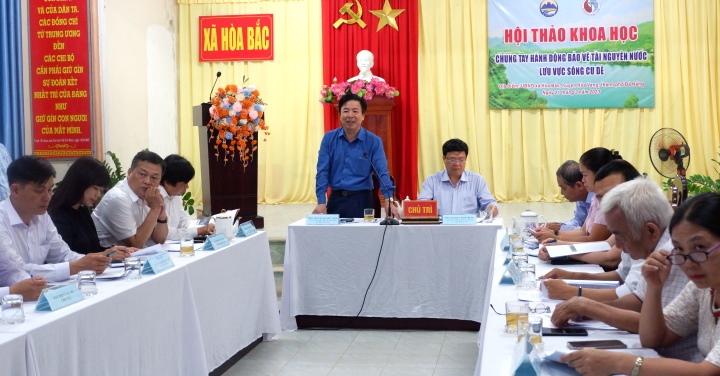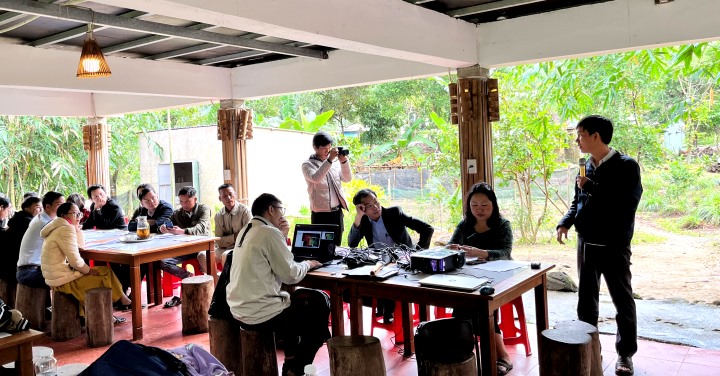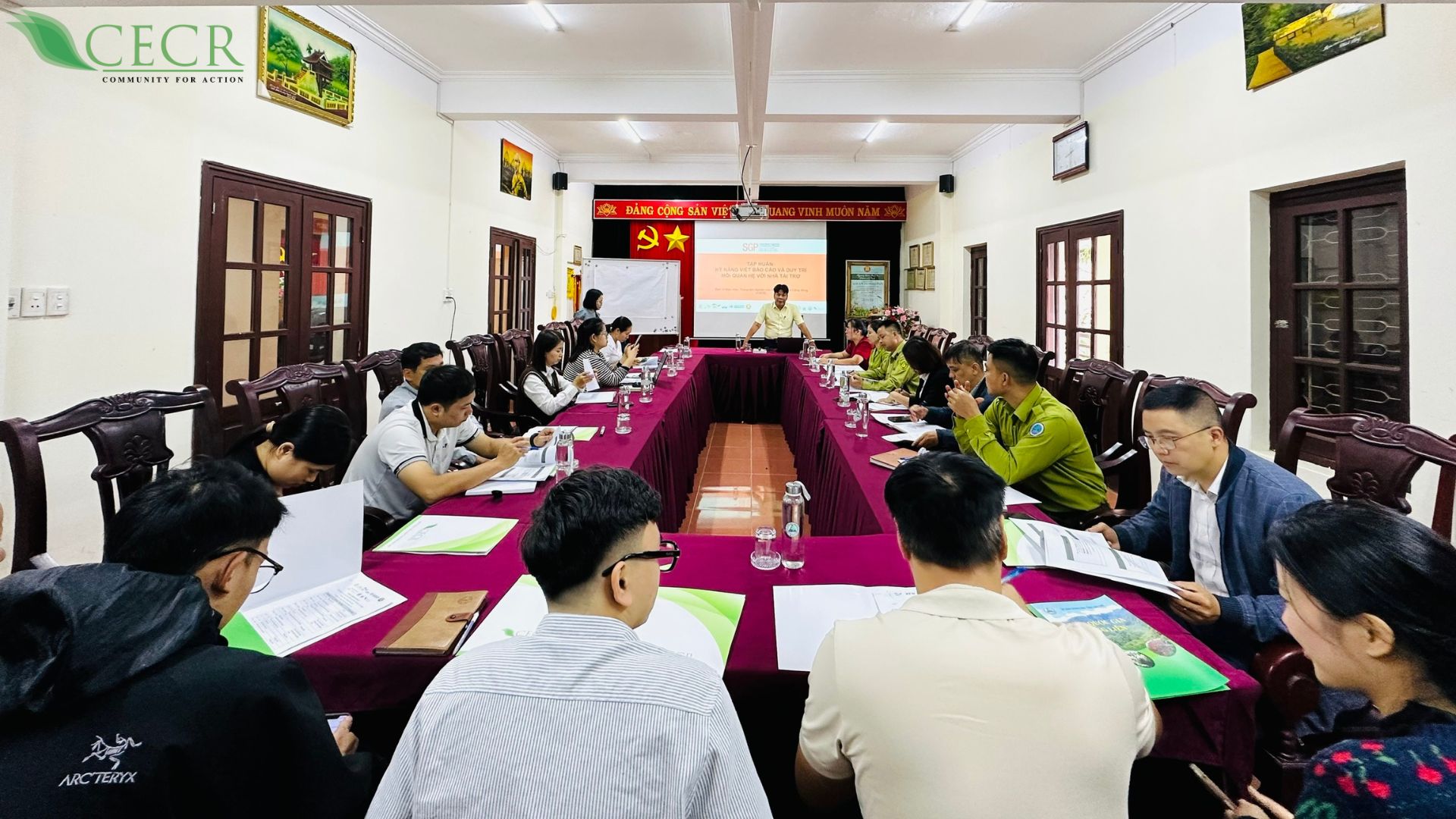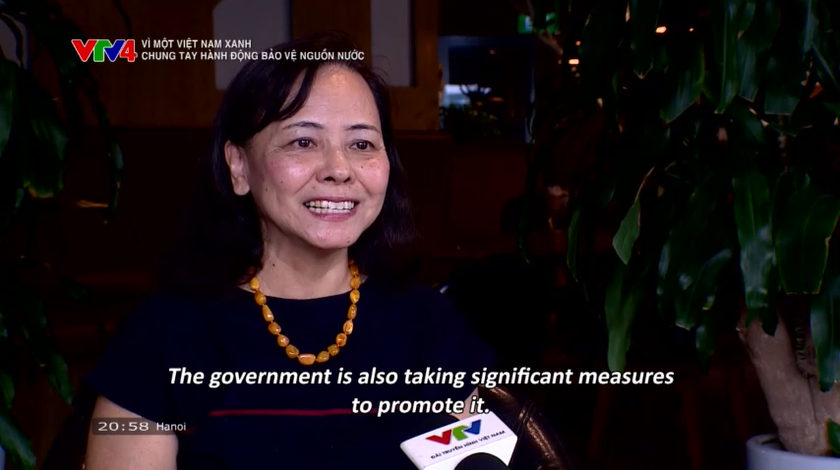Within the framework of activities to respond to World Water Day 2023, on the afternoon of March 21, the Department of Natural Resources and Environment held a scientific conference with the theme “Join hands to protect water resources in Cu De river basin” in Hoa Bac commune, Hoa Vang district. Deputy Director of the Department of Natural Resources and Environment Nguyen Quang Vinh and Vice Chairman of Hoa Vang District People’s Committee Nguyen Thuc Dung co-chaired the workshop. Attending the workshop were the Secretary of Hoa Vang District Party Committee To Van Hung.
Scientific conference “Join hands to protect water resources in Cu De river basin” in Hoa Bac commune, Hoa Vang district
The conference is a forum for managers, representatives of local authorities, representatives of the population community and scientists to share and contribute knowledge, experience and understanding to attract and promote joint action to protect water resources in the Cu De river basin; at the same time, giving comments on the Action Plan to protect water resources in Cu De river basin, especially on the river section where water is exploited for domestic water supply.
Challenges in protecting the water quality of Cu De river
Located in the north of the city, flowing from West to East through Hoa Bac commune, Hoa Lien and Hoa Hiep ward, with an area of basin up to the mouth of the river about 417.2 km2, Vu Gia river is identified as an inexhaustible source of water. Importantly, it can be exploited to meet up to 40% of the water demand in Da Nang city, with a vision of 2050, equivalent to 400,000 m3/day. In the development strategy and ensuring water security, the North river lake upstream of Cu De river is calculated and designed with a useful capacity of up to 50 million m3, acting as a strategic water reserve of the country in Da Nang city.
The development of the Cu De river water source will help Da Nang reduce its dependence on the Vu Gia river, which currently accounts for about 95% of the city’s total water demand. This means that Da Nang will reduce facing challenges related to drought, saltwater intrusion, the operation of hydroelectric power plants in the upstream Vu Gia – Thu Bon river basin, and the lack of energy resources. Renewable energy sources such as wind power, solar power, etc. participate in adjusting the power generation time to discharge water downstream of hydropower plants and water pollution due to socio-economic development activities in the basin. Vu Gia – Thu Bon river.
It can be said that one of the first factors affecting the water quality of the Cu De river basin is agricultural, forestry and fishery production in Hoa Bac commune. Accordingly, agricultural farming activities using fertilizers and plant protection chemicals have affected and polluted water sources from residues of fertilizers and pesticides; Livestock activities in scattered households in villages are not guaranteed in terms of environmental conditions, stables do not have treatment systems, and the amount of waste discharge affects the quality of water sources.
Along with that, the exploitation of planted forests, burning of vegetation in the watershed, and free cultivation on sloping land by local people increase soil leaching and erosion, and change forest cover, especially in the quality of forest cover (canopy). This is a factor that has a great influence on the ability to regulate surface runoff, flood transmission time, and the degree of material transfer into rivers and streams and downstream plains. This activity can also increase the ability to wash away sediment and other pollutants that cause sedimentation in the lake bed and affect water quality.
Currently, Hoa Bac commune has begun to develop various types of outdoor tourism, sightseeing, and small entertainment along rivers and streams in the upper Cu De River; If there is no solution to manage the waste from this activity well soon, this may be one of the factors affecting the quality of water in the exploitation area. In addition, construction, traffic, and mining activities in Hoa Vang district in general and Hoa Bac commune in recent years have also been factors causing pollution to Cu De river basin water.
Training on propaganda to raise community awareness in protecting the Cu De river water source in Hoa Bac commune, Hoa Vang district
In particular, the saltwater intrusion in the estuaries causes the depletion of water resources in the dry season with an increasing frequency, showing the importance of finding solutions to protect water sources from the Vu Gia River upstream, both in terms of quantity and quality of water sources, in the context of climate change, increasingly extreme natural disasters, unpredictable developments
Join hands to act
Currently, to ensure the highest priority for the purpose of domestic water supply, Da Nang has made a map to determine the scope of the sanitary protection zone of the domestic water supply area of the surface water exploitation project on the Cu De River. Accordingly, within the sanitary protection zone of the daily-life water supply area, organizations and individuals, when carrying out activities that affect the function of the water source protection corridor, must have a unanimous opinion by documents of the Department of Natural Resources and Environment and implement strict regulations on water resource protection, water reservoir safety protection and other relevant regulations. In particular, for establishments that are operating at risk of polluting water sources, there must be solutions to overcome or will be terminated to ensure the highest priority for the protection of the safety and security of water sources.
Speaking at the seminar, Deputy Director of the Management Board of Investment and Construction of Da Nang civil and industrial works Luong Thach Vy said that the Hoa Lien water plant project has a total investment of 1,170 billion VND, aiming purpose of raw water exploitation is with a capacity of 120,000m³/day in phase 1, using 100% of the water source in Cu De river. It is expected that in the near future, phase 2 will increase the capacity to 240,000m³/day. In order to protect the water quality of Cu De river, the Management Board organized to identify and set up landmarks on the water source protection corridor (110 landmarks), and held a public meeting for people in the protected corridor area. Know and comply with regulations on water protection. At the same time, organize the establishment and identification of sanitary protection zones in areas where domestic water is taken; coordinate with the Department of Natural Resources and Environment and local authorities to propagate and support organizations, individuals and households with solutions on wastewater treatment and water resource protection in the Cu De river basin.
According to the Deputy Director of the Management Board of Investment and Construction of Da Nang Civil and Industrial Works, to reduce the sedimentation of the lake bed, increase the life of the works as well as ensure the water quality in the Cu De river basin, the management has proposed to the competent authorities to develop a plan to strengthen the areas prone to landslides, to periodically clean and dredge the lake bed to maintain and ensure the reservoir’s capacity; strengthen the management of watershed protection forests; regularly propagate and disseminate to the people to raise their awareness of environmental protection in the Cu De river basin; At the same time, it is proposed that local authorities study and plan to restore and regenerate natural forests, increase the area of land for perennial crops to reduce the risk of landslides and erosion in the river basin when people harvest mass production of trees over a large area.
Mr. Huynh Van Thang, Association for the Protection of Nature and Environment of Da Nang city, contributed ideas at the workshop
Participating in the workshop, Mr. Huynh Van Thang, from the Danang Association for Conservation of Nature and Environment, said that in the context of Da Nang in particular and localities in general, there are still limited resources. Regarding people, equipment and techniques to invest in systems of monitoring, forecasting and early warning on water resources, monitoring discharge, monitoring and warning of water quality, the mobilization of participation of the community, the cooperation of each organization and individual in the protection of water resources in the Cu De river basin is extremely necessary and of great significance.
Accordingly, Mr. Huynh Van Thang proposed that the city urgently establish groups and groups of communities to protect the water source of the Cu De river, in which the focus is on the sanitary protection zone and the domestic water supply area. of surface water exploitation works on Cu De river; develop a Regulation on coordination to protect the water quality of Cu De River and monitor hazardous waste sources that may arise from illegal gold mining activities upstream. At the same time, strengthen communication activities on water resources for indigenous people to know the value of the Cu De river water source; strictly monitor the discharge of waste from picnic activities, eco-tourism has been developing quite vibrantly upstream of the South American dam recent years.
According to Mr. Huynh Van Thang, in the model of a residential community protecting water resources, representatives of the residential community and units exploiting and using water resources are the key subjects. In particular, the units exploiting and using water resources will closely associate with the population community in performing their roles and responsibilities for water resource protection through activities such as information on plans and plans for the exploitation of water resources, quality of water sources; support and link water protection activities through financial funding for local water resource protection activities.
In addition, improving capacity and publicizing information for the community to effectively exercise the right to monitor water quality, discharge activities into the sanitary protection zone in the area where domestic water is taken, and promote river tourism. water associated with education, propaganda on the protection of water resources and responsible tourism; promote communication activities to protect water resources and watershed forests.
“Residential communities also promote their rights and responsibilities and roles through proposing and reflecting their opinions to water exploitation and use units, local authorities, and communication agencies. communication, non-governmental organizations to improve the efficiency and effectiveness of state management of water resources; promote the implementation of water protection activities of the community practically and effectively,” shared Mr. Huynh Van Thang.
Secretary of Hoa Vang District Party Committee To Van Hung speaks at the workshop
Speaking at the workshop, Secretary of Hoa Vang District Party Committee To Van Hung emphasized that to effectively implement solutions to protect the water sources of Cu De river, first of all, authorities at all levels as well as people need to install Cu river. To be in the right position with its potential and important role in the city’s water security. “Determining Hoa Vang’s responsibility in protecting the Cu De river water source, currently, one of the district’s 5 criteria for building “5 yess” is “people have the responsibility to protect forests and protect water sources”. with many specific solutions to promote propaganda to raise people’s awareness,” said Secretary of the Hoa Vang District Party Committee.
NGÔ HUYỀN


 Tiếng Việt
Tiếng Việt




